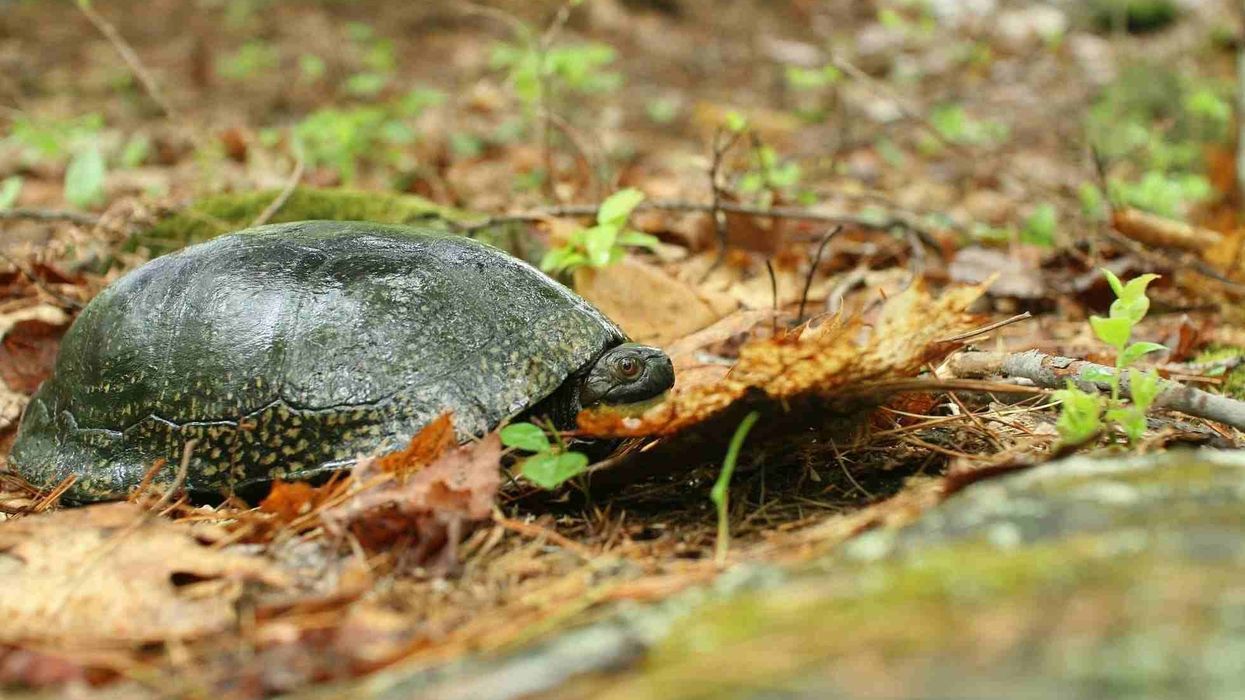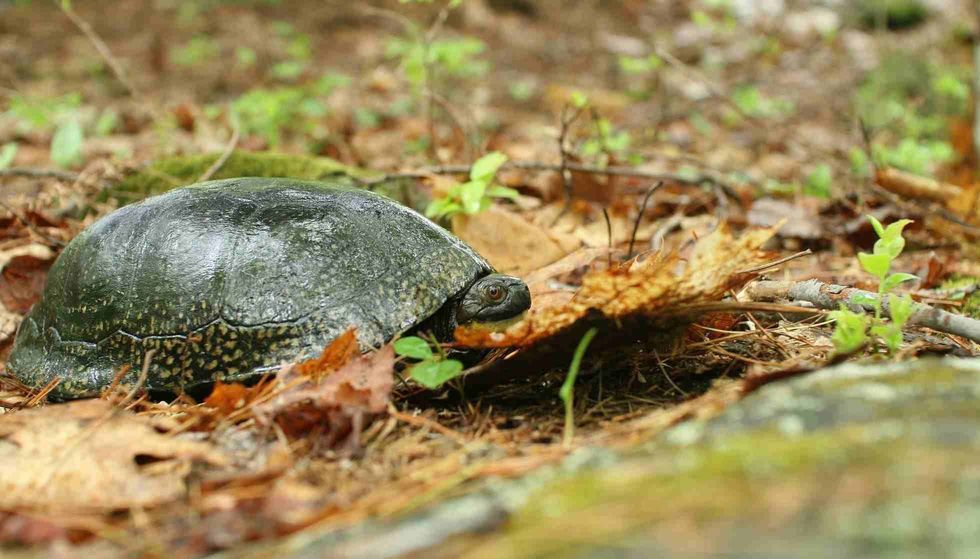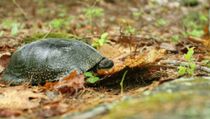Fun Blanding's Turtle Facts For Kids

Blanding's turtles are a species of medium-sized turtles found in the areas around the Great Lakes in Canada and the USA. They have a semi-terrestrial and semi-aquatic lifestyle and usually live in wetlands.
Their upper shell, or carapace, is usually black or dark brown but their uniqueness lies in their bright yellow chin and throat. Their lower shell is yellow too. Their head and legs are dark with yellow spots.
They mostly live in wetland habitats. They reach maturity at about 12-18 years of age and their life span is about 75 years.
The females lay eggs in perfect nesting sites. Nesting sites play a vital role in their reproduction process.
Their habitats range over a vast variety of places, but their conservation status is Endangered in the IUCN Red List and their population is decreasing. This is largely due to hunting, habitat loss, and predators. These creatures love wetlands and they love the water as well as the land.
Their reproduction process happens once a year and the females lay eggs. They are omnivores who eat fish, frogs, invertebrates, and also nuts, seeds, and vegetables.
If you want to read more amazing animal facts, please check out green sea turtle facts and softshell turtle facts.
Blanding's Turtle Interesting Facts
What type of animal is a Blanding's turtle?
The Blanding's turtle (Emydoidea blandingii) is a type of turtle found in Central and Eastern Canada and the United States of America.
What class of animal does a Blanding's turtle belong to?
The Blanding's turtle (Emydoidea blandingii) belongs to the Reptilia class of the Animalia kingdom.
How many Blanding's turtles are there in the world?
The exact number of Blanding's turtles in the world is unknown. However, their conservation status is ‘Endangered’ on the IUCN Red List, with decreasing populations.
This means there are very few of them left in the wild. However, steps have been taken to rehabilitate them by both Canada and the USA. Though their populations are still decreasing, they are thriving in captivity.
Where does a Blanding's turtle live?
The Blanding's turtle (Emydoidea blandingii) is found in Central and Eastern Canada and the United States of America. They can be found scattered throughout these two countries.
They have a vast range and can be found in Nebraska, Minnesota, Nova Scotia, Ontario, New York, Wisconsin, Missouri, Illinois, Indiana, and Iowa. Their geographic range centers around the Great Lakes, but despite their vast habitat, their conservation status is Endangered in the wild.
What is a Blanding's turtle's habitat?
Blanding's turtles are semi-terrestrial and semi-aquatic creatures that live mostly in wetland habitats, where they can find aquatic vegetation. They prefer natural wetland habitats.
They also like to submerge in shallow water. They like living in ephemeral wetland habitats so they can avoid the predators that are usually found in permanent wetland habitats. They use the grassland habitat beside the wetlands to live in the summer and take shelter.
In the winter, they are found in ponds, bogs, and marshes. Female Blanding's turtles lay their eggs on land. They usually build their nest on land with very little to no vegetation.
The reason behind this is that in a land with no vegetation, the chances of a predator taking their eggs are lower. Nesting and finding the perfect nesting spot are very important for these turtles.
Who do Blanding's turtles live with?
Older Blanding's turtles usually live in groups. This gives them strength in numbers. In one wetland habitat, about 20-50 turtles can live together. They also gather together in October and November and hibernate together until March. They also travel a little in the water and on land in groups. Their preferred habitat is wetlands.
How long does a Blanding's turtle live?
In the wild, their life span can be up to 75 years. This means in ideal conditions and a proper habitat they can live up to 75 years of age, but due to illegal hunting and the illegal pet trade, these turtles have Endangered conservation status.
How do they reproduce?
The mating season for Blanding's turtles begins after the winter period, usually in March and April. The females of the species reach sexual maturity at the age of about 18, while the males reach their sexual maturity far quicker at the age of 12.
In the mating process, the females seem to be in control, but the males can be quite violent while mounting. They usually begin their mating process in the water.
After the mating is completed, the females lay eggs in June and July. They can store the sperm in their bodies and fertilize them later.
The females search for a proper place to nest and after finding the correct nesting place, they can lay up to 25 eggs in one clutch. Nesting sites have to be placed with little to no vegetation to make sure fewer predators approach the eggs.
Blanding's turtles are polyandrous animals. This means the females have multiple males as partners during the mating season.
Their egg clutches are a product of two or three males and it is very rare to see a female Blanding's turtle have only one mate in their life. After the eggs are laid more than one male takes care of one nest if it has his eggs in it.
Multiple males protecting one nest is called multiple paternity. The females lay eggs and nest once a year, they are also known to nest nocturnally.
They search extensively for the perfect nesting site and can travel far and wide to find the perfect nesting place. In the wild, the incubation period of these turtles is about 80-128 days, but in captivity, in the right amount of heat, it can be brought down to about 50-70 days.
The hatchlings become immediately independent after hatching. They follow the scent trail of other hatchlings to reach the nearest wetlands, which is their preferred habitat. They can reach the wetlands in as little as nine days.
What is their conservation status?
Blanding's turtles are listed as Endangered on the IUCN Red List. They also have a decreasing population throughout their habitats.
Blanding's Turtle Fun Facts
What do Blanding's turtles look like?
The Blanding's turtle is a medium-sized species of turtle found around the Great Lakes of Canada and the USA. They are a very unique breed of turtles. Their upper shells are usually dark brown or black.
Their carapace is also very domed. Their length is about 7.1-9 in (18- 23 cm) in adulthood, and their weight is about 1.5-3 lb (0.75-1.4 kg).
The most unique feature of this turtle is that they have a yellow chin and throat. Their upper shell is domed and black but the lower shell is yellow and flat. The yellow lower shell and their bright yellow chin and throat are the most unique features of these reptiles.
They also have dark blotches on the yellow of their lower shells. The turtle's legs and head are mostly dark with yellow spots.
They also have webbed toes. The plastrons of the male turtles are usually a little more concave than the females, but there are no other distinguishable features that can be seen at a glance. Their carapace is very smooth and black.
The juvenile Blanding's turtles are smaller in length and their ventral shells have a tan color. They also have a thinner tail than the adults.
How cute are they?
Blanding's turtles are a very beautiful and cute species of medium-sized turtles. Especially the young turtles are very cute.
How do they communicate?
For Blanding's turtles, communication is mostly needed during mating. During the mating season, they often rely on tactile senses like climbing and gulping. The males also sway their bodies and spew water onto the females' heads to attract them to mate with him.
Juvenile Blanding's turtles also need to rely on communication. They use their sense of sight and smell to survive.
They follow the smell trail of other hatchlings to reach a wetland where they can live. The adults of this turtle species also vocalize when they are underwater. Although scientists are not sure why they vocalize while swimming, it can be to attract a mate or ward off predators, or both.
How big is a Blanding's turtle?
The average length of an adult Blanding's turtle is about 7.1-9 in (18- 23 cm). They are smaller turtle species and are very cute and docile.
How fast can a Blanding's turtle swim?
The exact speed of Blanding's turtles underwater is unknown. However, it is known that they are not too fast.
Be it on land or underwater, they are slow and steady. They are good swimmers and love to be in the water, but they are not too fast. This turtle species likes to move and they move every day on land and in water.
How much does a Blanding's turtle weigh?
The average weight of adult Blanding's turtles ranges from 1.5-3 lb (0.75-1.4 kg). They are a smaller species of reptiles and can be very cute and docile.
What are the male and female names of the species?
Like every other turtle, there is no specific name for the male and female Blanding's turtles.
What would you call a baby Blanding's turtle?
Like every other turtle species, the baby Blanding's Turtles are called hatchlings.
What do they eat?
Blanding's turtles are omnivores. They eat crayfish, fish, frogs, insects, and other invertebrates.
They can consume their prey alive or as carrion, but since they are omnivorous, they also eat leaves, seeds, and nuts. It has been observed that the diet of the adult Blanding's turtles is more meat-centric, as 75% of their food is meat, while juvenile Blanding's turtles have a more plant-based diet.
Are they poisonous?
No. Like most other turtle species, the Blanding's turtles are not venomous or poisonous. They are very docile creatures that rarely bite or fight people.
Would they make a good pet?
Blanding's turtles make for good pets. They are medium-sized turtle species with docile and sweet personalities, but since they are an endangered species, you cannot always own them everywhere. Some places allow you to own Blanding's turtles.
They thrive in semi-terrestrial and semi-aquatic habitats. They can also eat a variety of food, which makes taking care of them fairly easy.
They are not tiny, but they do not get too big. This means space does not become a problem for these turtles. They thrive in a range of habitats and the hatchlings are pretty hardy if you take care of them properly.
Did you know...
The main reason for the disappearance and lessening populations of the Blanding's turtles is the pet trade, hunting, and habitat loss.
These turtles can be both terrestrial and aquatic. Thus they choose a shallow water source and wetland habitats for living in.
Why are Blanding's turtles important?
Turtles are very important for the ecosystem. They eat a variety of food that includes both plants and animals, like insects and frogs.
Blanding's turtles also play an important role in the ecosystem. However, because of illegal poaching and habitat loss, they are decreasing in number day by day, which could be catastrophic if they go extinct.
That is why several steps have been taken by both Canada and the USA to prevent these turtles from going extinct. Not only is the Blanding's turtle beautiful but also very important for the ecosystem.
How many eggs do Blanding's turtles lay?
After finding proper nesting sites, a pregnant female Blanding's turtle can lay up to 22 eggs in one clutch. The numbers vary from turtle to turtle but the average number of eggs in a clutch is about eight.
Here at Kidadl, we have carefully created lots of interesting family-friendly animal facts for everyone to discover! For more relatable content, check out these drum fish facts and skate fish facts for kids!
You can even occupy yourself at home by coloring in one of our free printable Blanding's turtle coloring pages.
We Want Your Photos!
More for You
Bachelor of Arts specializing in Journalism and Mass Communication, Postgraduate Diploma in Sports Management

Moumita DuttaBachelor of Arts specializing in Journalism and Mass Communication, Postgraduate Diploma in Sports Management
A content writer and editor with a passion for sports, Moumita has honed her skills in producing compelling match reports and stories about sporting heroes. She holds a degree in Journalism and Mass Communication from the Indian Institute of Social Welfare and Business Management, Calcutta University, alongside a postgraduate diploma in Sports Management.
Bachelor of Journalism and Mass Communication

Ankit ShindeBachelor of Journalism and Mass Communication
Ankit is a Journalism and Mass Media graduate from the University of Mumbai. With experience in SEO, blog and article writing, and fiction writing, he is a versatile writer and content creator. In his free time, Ankit enjoys reading, writing, and listening to music.
Disclaimer
1) Kidadl is independent and to make our service free to you the reader we are supported by advertising. We hope you love our recommendations for products and services! What we suggest is selected independently by the Kidadl team. If you purchase using the Buy Now button we may earn a small commission. This does not influence our choices. Prices are correct and items are available at the time the article was published but we cannot guarantee that on the time of reading. Please note that Kidadl is a participant in the Amazon Services LLC Associates Program, an affiliate advertising program designed to provide a means for sites to earn advertising fees by advertising and linking to Amazon. We also link to other websites, but are not responsible for their content.
2) At Kidadl, we strive to recommend the very best activities and events. We will always aim to give you accurate information at the date of publication - however, information does change, so it’s important you do your own research, double-check and make the decision that is right for your family. We recognise that not all activities and ideas are appropriate for all children and families or in all circumstances. Our recommended activities are based on age but these are a guide. We recommend that these ideas are used as inspiration, that ideas are undertaken with appropriate adult supervision, and that each adult uses their own discretion and knowledge of their children to consider the safety and suitability. Kidadl cannot accept liability for the execution of these ideas, and parental supervision is advised at all times, as safety is paramount. Anyone using the information provided by Kidadl does so at their own risk and we can not accept liability if things go wrong.
3) Because we are an educational resource, we have quotes and facts about a range of historical and modern figures. We do not endorse the actions of or rhetoric of all the people included in these collections, but we think they are important for growing minds to learn about under the guidance of parents or guardians.







